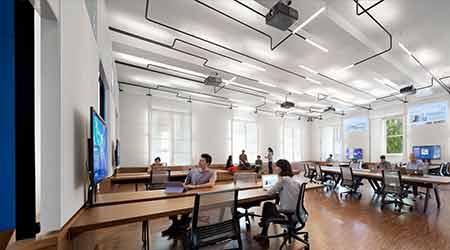 The lighting concept at the David and Helen Gurley Brown Institute for Media Innovation at Columbia University embraced the institute’s mission of speculating how stories are discovered and told in a networked, digital world with a series of intertwining luminous elements.Michael Moran
The lighting concept at the David and Helen Gurley Brown Institute for Media Innovation at Columbia University embraced the institute’s mission of speculating how stories are discovered and told in a networked, digital world with a series of intertwining luminous elements.Michael MoranMedia Research Center Chooses LEDs For Flexibility, Simple Maintenance
Columbia University's Brown Institute for Media Innovation building in New York City uses LEDs in a wide variety of applications.
The David and Helen Gurley Brown Institute for Media Innovation at Columbia University in New York City is devoted to the co-evolution of technology and storytelling. The 4,600-square-foot immersive space promotes a more synergistic educational experience between teacher and student. When deciding on the lighting strategy, the challenge was to design lighting that would support the institute’s varied programmatic needs: classroom, workshop, film screening, conferences, panel discussions, concerts, and even cocktail parties.
In addition to flexibility, the university required very simple maintenance. To answer these needs, the lighting strategy includes the use of a single fixture in three different capacities.
The mission of the institute is to sponsor thinking, building, and speculating on how stories are discovered and told in a networked, digital world. As the lighting concept embraced this mission with a series of intertwining luminous elements, achieved with LEDs embedded within pipework, building a network of ambient light for the room. Each element within the network provides indirect lighting along its length, with a direct punctuation at its end.
The final layer is built in to the walls. Backlight, integrated into the perimeter fabric screen, adds depth and richness to the space. It helps define the screen and allows the structure holding it to be seen as an extension of the ceiling network.
The fixtures are low-voltage and are magnetically held in place. This offered the freedom to easily shift fixture positions during construction to optimize the light effect and minimize reflections in the perimeter glazings. Being held in place magnetically also means modules can be removed and replaced as needed.
Related Topics:















